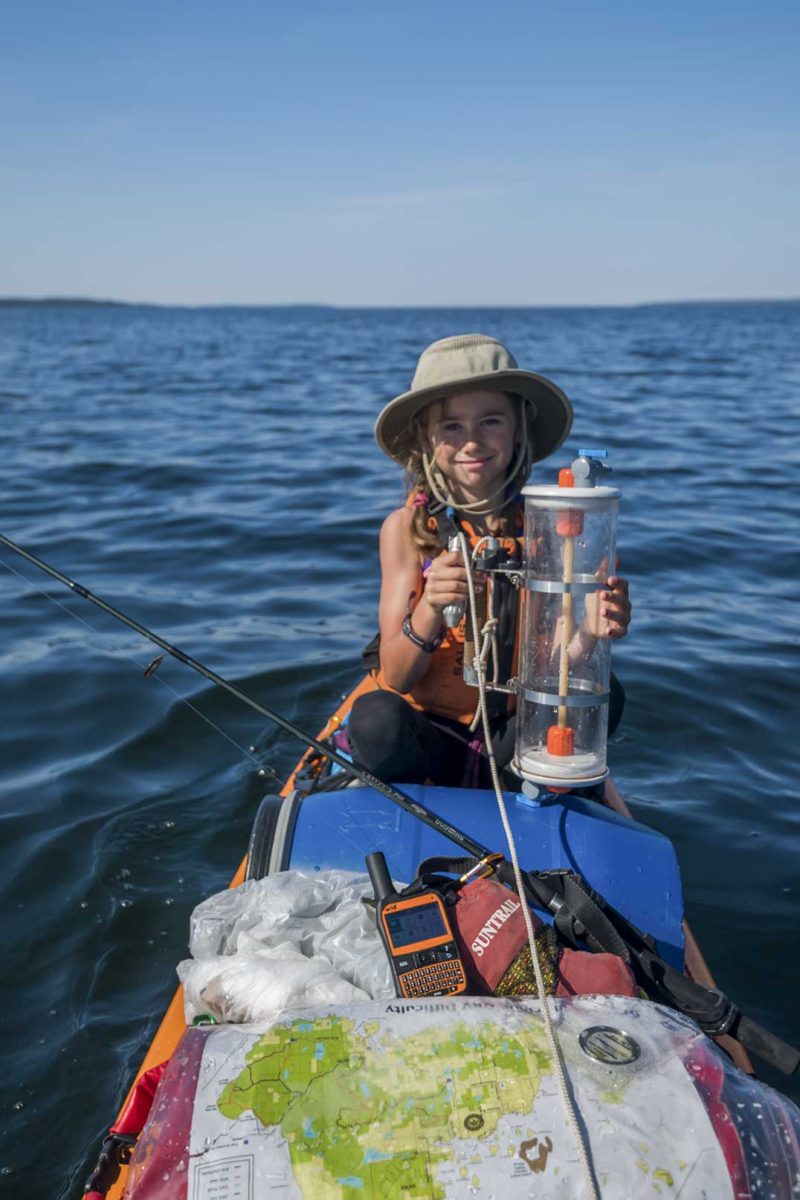LAKE HURON – A nine-year-old citizen scientist is paddling approximately 475 kilometres across Lake Huron with her dad, offering both the trip of a lifetime and the opportunity to gather important data about the presence of microplastics in the lake’s waters.
Although canoes or kayaks may be the first watercraft that come to mind upon reading the word ‘paddling,’ the duo is undertaking this journey aboard a single 14-foot Blu Wave stand-up paddleboard (SUP) that can accommodate both travellers and all their gear.
Acadia has been able to partake in incredible adventures throughout her upbringing. Her dad Scott Parent, who is sharing in this voyage with her, runs a guided SUP expedition outfitter in Tobermory called Fathom Paddle Guiding. His past journeys in this area included a solo unassisted crossing of Georgian Bay in 2011 and a winter crossing of Georgian Bay in 2015.
“This is the first expedition of this nature with a kid in tow, which is really precious cargo,” said Mr. Parent. “She’s been missing her mom and her siblings a bit along the way, but as far as the tripping elements are concerned along the water, Acadia’s entirely made for it. She’s been doing it since she was young.”
Acadia’s scientific motivation for this trip is in collecting water samples to assess the presence of plastic in Lake Huron. She and her dad approached the Lake Huron Centre for Coastal Conservation (LHCCC) because Acadia wanted to collect water samples along the way.
“It’s great to see community champions like this, especially at a young age,” said Daniela Klicper, coastal stewardship co-ordinator at LHCCC.
Acadia has been collecting surface samples daily and deep-water samples in some of the bigger channels through which they travel. This is a major benefit for LHCCC which, with its small staff, cannot effectively be out on the water regularly.
“We rely on citizen science volunteers to be the eyes and ears of Lake Huron and we can do more analysis and research based on what they’ve found,” said Ms. Klicper, adding that they have not received much data from northern Lake Huron in recent surveys, so this journey will offer a significant benefit.

Their paddling adventure began on the northern edge of Drummond Island, Michigan, and led past Cockburn Island before reaching Manitoulin at the Mississagi Lighthouse. Their path skirted the southern and eastern shores to Cape Smith in Wiikwemkoong, where they will head across the water to Odjig Island or Killarney, depending on the conditions. From there, it’s a fairly straightforward route along the Georgian Bay coast until their final destination of Penetanguishene.
This route follows the trail of the Métis migration route of 1828 between Drummond Island and Penetanguishene. It’s quite the distance and the duo has set aside the whole month of July for their expedition.
“We’re being super conservative for our time on the water. We don’t go out if there’s any heavy winds. If I were solo, I might try going out in tougher conditions,” said Mr. Parent.
One might rightly suspect that carrying a month’s worth of food and supplies would be well beyond the scope of an SUP’s holding capacity. They are outfitted for 10 days’ worth of food on each leg of the journey and check in with their family members at rendezvous points along the way.
On Manitoulin, the family reunited at Mississagi Lighthouse and at South Baymouth. Acadia uses these rendezvous points to swap her collected samples for fresh containers. The paddlers always carry a tent, sleeping bag, first aid kit, clothing and camera gear along their whole journey and their food supplies are designed to tide them over if they lose a couple of days’ travelling time due to weather conditions. They also have a SpotX communication device which uses satellite signals to connect them with their support team and alert them to any emergencies that may arise.
LHCCC began a microplastic project last year in which it tasked citizen science volunteers to take one-litre water samples from the same spot at the beginning and end of the summer. The centre conducted in-house analysis on the water samples.
Analysis from last year’s samples focused on plastic fragments, microbeads, film and microfibres. Based on LHCCC’s internal study, they found 466 instances of microfibres (which often come from clothing and tend to be stringy), 10 films and 22 plastic fragments. Microbeads, fortunately, were not found in any of the samples. Of the 68 samples received, only six had no evidence of any kind of plastic.
Ms. Klicper described the morning when Acadia and her dad came to visit their centre in Goderich, learned about plastics in Lake Huron and sent back reports about what plastics they found on a waterfront walk later that morning.
“The motivation and passion for a nine-year-old was incredible, plus there’s that adventure along with it. She gets to go on a month-long trip; I quite envy her,” said Ms. Klicper with a laugh.
Mr. Parent is sharing photos and occasional updates from the trip on his Instagram account, @ScottParentPhoto. They hope to compile a small documentary from this voyage and have been filming along the way.




